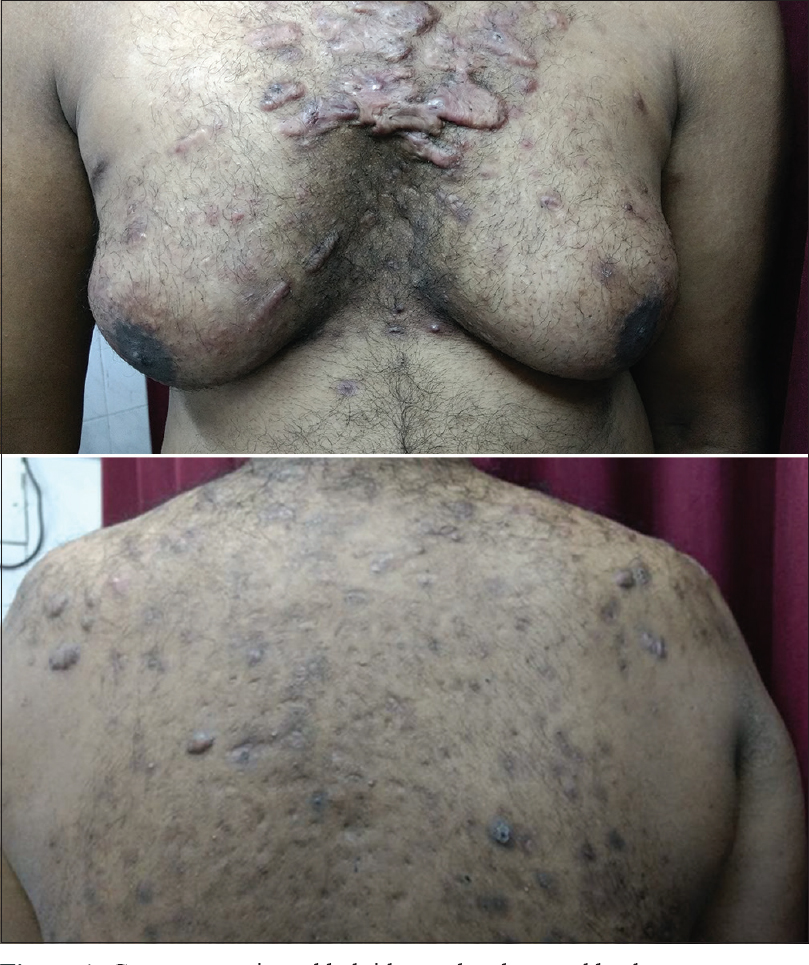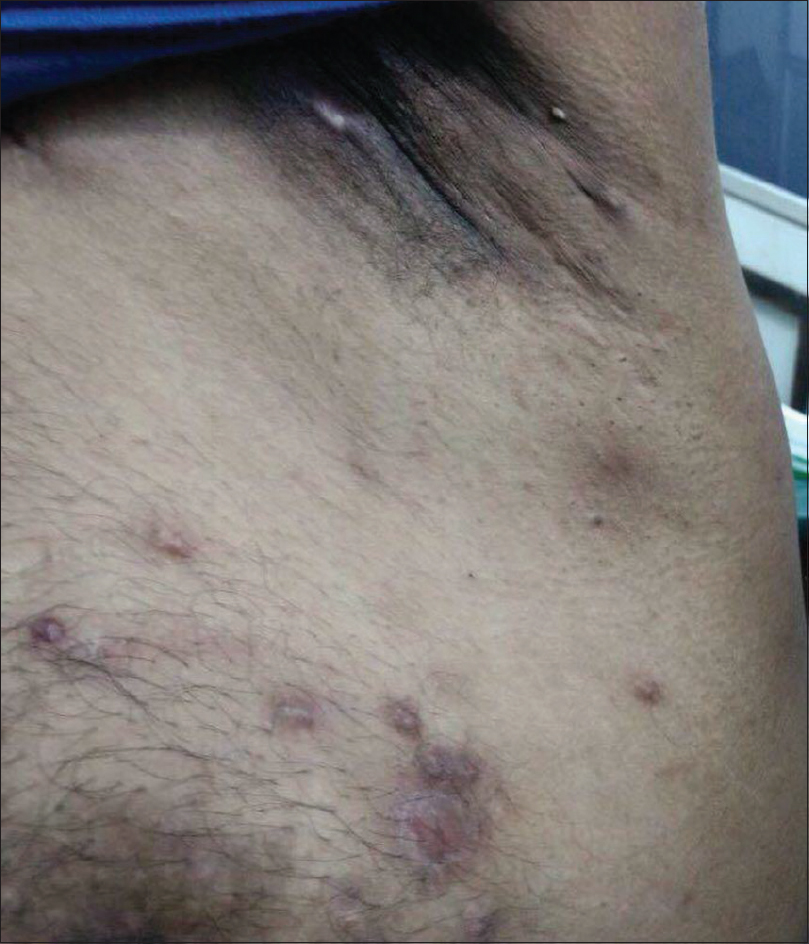Translate this page into:
An outlandish association of Klinefelter syndrome
Correspondence Address:
A Ramesh
Department of Dermatology, Madras Medical College and Rajiv Gandhi Government General Hospital, Chennai, Tamil Nadu
India
| How to cite this article: Sivayogana R, Ramesh A, Sampath V. An outlandish association of Klinefelter syndrome. Indian J Dermatol Venereol Leprol 2017;83:708-709 |
Sir,
Acne conglobata and hidradenitis suppurativa are chronic inflammatory diseases, characterized by infundibular hyperkeratosis, follicular dilatation, cystic swelling, subcutaneous abscesses, sinus tract formation and scarring.[1] Severe disease manifestations make it mandatory to evaluate the presence of any underlying risk factors, especially hormonal.
A 27-year-old male presented with recurrent painful nodules occurring over the face, arms, trunk, abdomen, axillae, groin and gluteal region since the age of 8 years. The nodules over the axillae, groins and gluteal region progressively increased in size leading to abscess formation. Spontaneous rupture of these abscesses led to sinus tract formation with purulent discharge leading to extensive scar formation. The nodules over the face, trunk and arms healed with scarring. The patient reported increase in the size of breasts since the age of 13 years. There were no systemic symptoms or ulceration of the skin. There was no history of lesions over the scalp. There were no similar complaints in his family members.
On examination, the patient had central obesity with a height of 188 cm and weight of 95 kg. Body and facial hairs were sparse. Bilateral gynaecomastia was present [Figure - 1]. Penis was normal in length. Testes were palpable within the scrotum. Numerous papules, pustules, and fluctuant nodules were seen over the chest, back, abdomen and buttocks. In addition, pustules and nodules were present in the left axilla [Figure - 2]. Furthermore, keloids [Figure - 1], atrophic scars and hyperpigmentation were present over the trunk, abdomen and arms. There were only a few papules over the face.
 |
| Figure 1: Gynaecomastia and keloids on the chest and back |
 |
| Figure 2: Nodules and pustule in the left axilla |
The patient's phenotypic features led to a clinical suspicion of Klinefelter syndrome. On evaluation, hormonal profile demonstrated reduced serum testosterone 1.5 ng/ml (2.6–13.5 ng/ml), raised follicular stimulating hormone 30.5 mIU/ml (normal <10.0 mIU/ml) and luteinizing hormone 21.9 mIU/ml (normal <6 mIU/ml) levels. Semen analysis showed azoospermia. The volume of both testes was reduced (right testis: 6 ml and left testis: 5 ml). Chromosomal analysis revealed a 47XXY karyotype. Fasting and postprandial blood sugar values were 90 mg/dl and 140 mg/dl, respectively. Fasting insulin level was 10 μIU/ml (8–11 μIU/ml), but his postprandial insulin was 20 μIU/mL which falls in the high normal range (>20 μIU/Ml is indicative of insulin resistance), leading to a diagnosis of early insulin resistance state. Complete blood count showed lymphocytosis. Bacterial culture from pustules showed no growth.
Histopathological examination of nodules showed ducts and cystic dilatation lined by squamous epithelium with surrounding inflammatory infiltrates predominantly consisting of neutrophils and lymphocytes in the lower and mid dermis.
The patient was treated with oral isotretinoin 40 mg/day and tablet clarithromycin 500 mg twice daily. Topical clindamycin was prescribed for external application over the axilla, groins and buttocks. After 6 months of isotretinoin therapy, all acne conglobata lesions improved and there were no new lesions. Surgical correction of gynecomastia was planned by the department of plastic surgery on an elective basis. The patient was advised to reduce weight, exercise regularly, avoid sugar, grains, dairy products, whey protein and consume liberal quantities of cruciferous vegetables and green tea to reduce insulin resistance.[2]
It is a general belief that increased androgen levels predispose to severe acne formation.[3] Klinefelter syndrome is a genetic disorder of males with additional X chromosome and reduced androgen levels.[4] The use of androgens to treat tall stature, exposure to anabolic steroids, halogenated aromatic hydrocarbons and androgen producing tumors may predispose to acne in Klinefelter syndrome.[5] Even though all these risk factors were not documented in our patient, he developed severe acne. This shows that, apart from the role of androgens, several other factors such as high glycemic diet and associated insulin resistance lead to increased production of insulin like growth factor-1 (IGF-1) from the liver. This causes enhanced mammalian Target Of Rapamycin C1 (mTORC1) and reduced Forkhead box class O (FoxO1) expression in the skin appendages, leading to hyper cornification of infundibulum, sebaceous gland hyperplasia and increased sebaceous lipogenesis resulting in the development of acne in Klinefelter syndrome.[2] Understanding the acne pathogenesis signifies that androgens may only serve as a prerequisite for acne development. The occurrence of severe prepubertal acne before androgenic surge should alert the physician towards endocrinological evaluation.[3] This was missed in this patient leading to a delayed diagnosis of Klinefelter syndrome. An extensive PubMed search showed only one previous published report of acne conglobata with Klinefelter syndrome by Wollenberg et al.[6]
To conclude, Klinefelter syndrome, though an androgen deficient state, is no longer considered as a protective factor for severe acne formation. This case is being reported to highlight an unusual association of Klinefelter syndrome with acne conglobata and hidradenitis suppurativa and to emphasize the role of insulin resistance and appropriate dietary intervention in the management of acne.
Financial support and sponsorship
Nil.
Conflicts of interest
There are no conflicts of interest.
| 1. |
Vasanth V, Chandrashekar BS. Follicular occlusion tetrad. Indian Dermatol Online J 2014;5:491-3.
[Google Scholar]
|
| 2. |
Melnik BC. Nutrient and growth factor signalling in acne sensed by foxO1 and mTORC1. In: Khanna N, editor. World Clinics Dermatology: Acne. Vol. 1. India: Jaypee Brothers Medical Publishers Ltd; 2014. p. 52-88.
[Google Scholar]
|
| 3. |
Layton AM, Eady EA, Zouboulis CC. Acne. In: Griffiths C, Barker J, Bleiker T, Chalmers R, Creamer D, editors. Rook's Textbook of Dermatology. 9th ed. West Sussex: Blackwell Publishing Ltd; 2016. p. 2343-406.
[Google Scholar]
|
| 4. |
Zitzmann M, Depenbusch M, Gromoll J, Nieschlag E. X-chromosome inactivation patterns and androgen receptor functionality influence phenotype and social characteristics as well as pharmacogenetics of testosterone therapy in Klinefelter patients. J Clin Endocrinol Metab 2004;89:6208-17.
[Google Scholar]
|
| 5. |
Traupe H, von Mühlendahl KE, Brämswig J, Happle R. Acne of the fulminans type following testosterone therapy in three excessively tall boys. Arch Dermatol 1988;124:414-7.
[Google Scholar]
|
| 6. |
Wollenberg A, Wolff H, Jansen T, Schmid MH, Röcken M, Plewig G. Acne conglobata and Klinefelter's syndrome. Br J Dermatol 1997;136:421-3.
[Google Scholar]
|
Fulltext Views
9,651
PDF downloads
686





